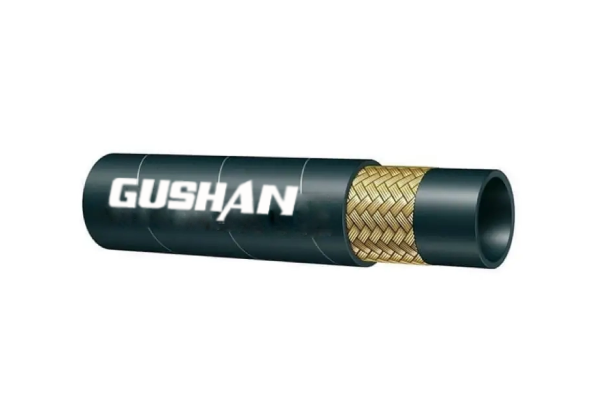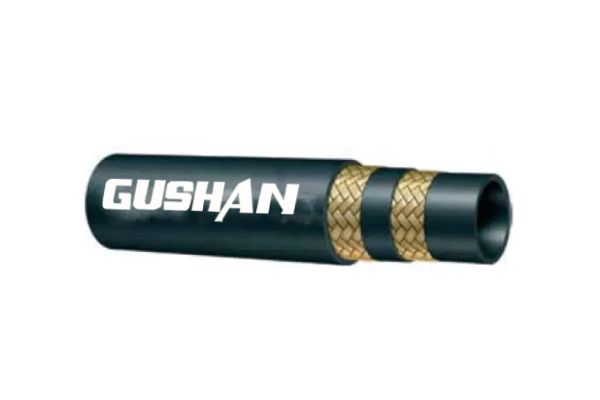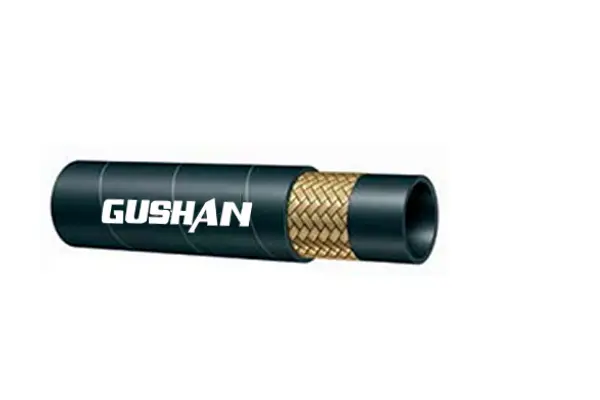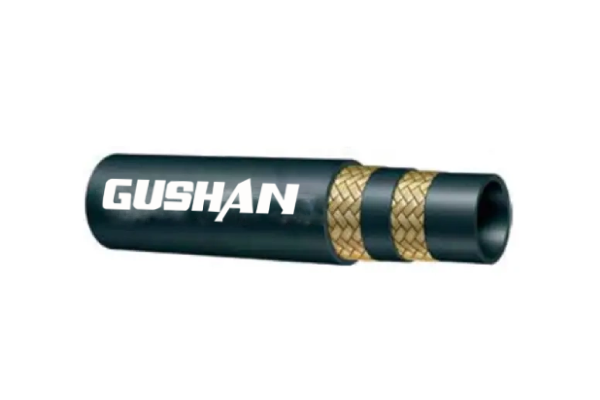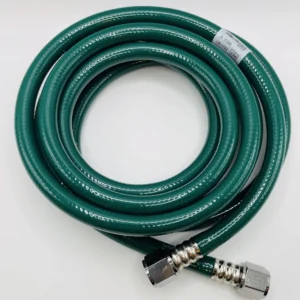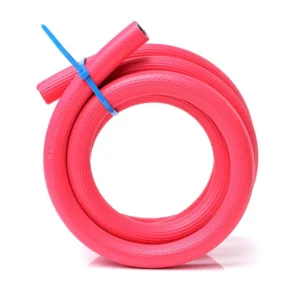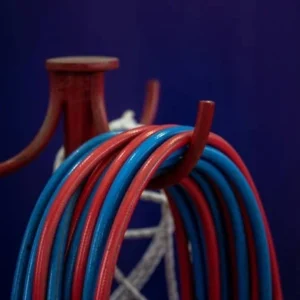We will dive into the key differences between R1 and R2 hydraulic hoses, two common types used in various industrial applications. We’ll explore their construction, pressure ratings, temperature ranges, and suitability for different operating conditions.
Understanding these distinctions is crucial for selecting the appropriate hose for your specific needs and ensuring optimal performance and safety within your hydraulic system.
By the end of this post, you’ll have a clear understanding of the key characteristics of R1 and R2 hoses, enabling you to make informed decisions regarding their selection and application in your hydraulic systems.
What is R1 Hydraulic Hose
R1 hydraulic hose is a common type of industrial hose used in various hydraulic systems. It’s characterized by a single-wire braid reinforcement layer that provides a balance of flexibility, strength, and pressure resistance.
Key Features:
- Single-wire braid reinforcement: This layer enhances the hose’s strength and pressure resistance while maintaining a good level of flexibility.
- Oil and abrasion resistance: R1 hoses are typically constructed with oil-resistant synthetic rubber inner tubes and covers, making them suitable for use with various hydraulic fluids and providing good resistance to abrasion.
- Temperature range: R1 hoses generally have a moderate temperature range, suitable for most industrial applications.
Applications:
R1 hoses are widely used in a variety of applications, including:
- General industrial applications: Such as in construction equipment, agricultural machinery, and material handling systems.
- Mobile equipment: Including trucks, buses, and off-road vehicles.
- Marine applications: In marine vessels and offshore platforms.
Advantages:
- Good balance of flexibility and strength: The single-wire braid reinforcement provides a good combination of flexibility for easy routing and sufficient strength to withstand moderate pressures.
- Cost-effective: R1 hoses are generally a cost-effective option compared to hoses with more complex reinforcement structures.
- Widely available: R1 hoses are readily available from many hydraulic hose suppliers.
R1 hydraulic hose is a versatile and cost-effective option for a wide range of applications where moderate pressure requirements and good flexibility are essential. However, it’s crucial to carefully consider the specific application requirements and select the appropriate hose type to ensure optimal performance and safety.
What Is R2 Hydraulic Hose
R2 hydraulic hose is a high-pressure hose designed for demanding applications. It’s characterized by its robust construction, featuring two layers of steel wire braid reinforcement. This double-braided structure provides exceptional strength and durability, enabling R2 hoses to withstand significantly higher pressures compared to single-braided hoses like R1.
The inner layer of steel wire braid provides excellent resistance to internal pressure, while the outer layer enhances the hose’s resistance to external abrasion, kinking, and crushing. This robust construction makes R2 hoses suitable for use in a wide range of demanding applications, including heavy-duty construction equipment, industrial machinery, and mobile hydraulic systems.
R2 hoses are typically manufactured with high-quality synthetic rubber inner tubes and covers, providing excellent resistance to a variety of hydraulic fluids, including petroleum-based oils, water-based fluids, and bio-degradable fluids. They also exhibit good resistance to heat, cold, ozone, and other environmental factors.
Due to their enhanced strength and durability, R2 hoses are often preferred in applications where high pressures, extreme temperatures, and harsh operating conditions are encountered. However, it’s important to note that R2 hoses may be slightly less flexible than single-braided hoses due to the additional layer of reinforcement.
Key Features of R2 Hydraulic Hose:
- Double-wire braid reinforcement: Provides exceptional strength and durability.
- High-pressure capability: Suitable for demanding applications with high-pressure requirements.
- Excellent abrasion and kink resistance: Offers enhanced protection against external damage.
- Good resistance to heat, cold, and various fluids: Suitable for a wide range of operating conditions.
- Wide range of sizes and configurations: Available in various sizes and configurations to meet specific application requirements.
R2 hydraulic hoses are a valuable asset in various industries, providing reliable and efficient fluid transfer in demanding operating environments.
Hydraulic Hose R1 vs R2
R1 and R2 hoses are both types of hydraulic hoses used to transfer fluids under pressure, but they differ significantly in their construction and capabilities.
R1 Hydraulic Hose
- Construction: Features a single layer of steel wire braid reinforcement.
- Pressure Rating: Designed for medium-pressure applications, typically handling pressures up to around 3,265 PSI.
- Flexibility: Offers good flexibility due to the single-braid construction.
- Applications: Commonly used in agricultural machinery, construction equipment, and general industrial applications where medium pressure and flexibility are required.
R2 Hydraulic Hose
- Construction: Features two layers of steel wire braid reinforcement. This double-braided structure significantly enhances its strength and durability.
- Pressure Rating: Designed for higher pressure applications, typically handling pressures up to around 5,800 PSI.
- Flexibility: Slightly less flexible than R1 hoses due to the additional layer of reinforcement.
- Applications: Suitable for demanding applications in heavy-duty construction equipment, industrial machinery, and mobile hydraulic systems where high pressures and harsh operating conditions are encountered.
Key Differences between R1 hydraulic hoses vs R2
| Feature | R1 Hose | R2 Hose |
|---|---|---|
| Reinforcement | Single-wire braid | Double-wire braid |
| Pressure Rating | Medium pressure | High pressure |
| Flexibility | More flexible | Less flexible than R1 |
| Durability | Good durability | Higher durability, more resistant to abrasion, kinking, and crushing |
| Applications | Medium-pressure applications, general industrial use | High-pressure applications, heavy-duty equipment |
When to Choose R1 Hydraulic Hose or R2
When to Choose R1 Hydraulic Hose
- Medium-Pressure Applications: R1 hoses are ideally suited for hydraulic systems operating within moderate pressure ranges, typically up to around 3,265 PSI. They are a suitable choice when the application doesn’t demand extremely high pressures.
- Cost-Conscious Projects: Due to their simpler single-wire braid construction, R1 hoses generally have a lower manufacturing cost compared to R2 hoses. This makes them a more economical option for projects where budget constraints are a significant factor.
- Flexibility and Maneuverability: The single-wire braid construction of R1 hoses provides good flexibility and a relatively small bend radius. This makes them suitable for applications where space is limited or where the hose needs to be routed through tight corners or complex pathways.
When to Choose R2 Hydraulic Hose
- High-Pressure Applications: R2 hoses are designed to handle significantly higher pressures compared to R1 hoses, typically up to around 5,800 PSI. They are essential for applications where high-pressure hydraulic fluid is regularly used, such as in heavy-duty construction equipment, industrial machinery, and high-pressure industrial processes.
- Enhanced Durability and Strength: The double-wire braid reinforcement of R2 hoses provides exceptional strength and resistance to abrasion, kinking, and crushing. This makes them ideal for applications where the hose is subjected to harsh operating conditions, such as exposure to extreme temperatures, vibrations, and potential impacts.
- High-Stress Environments: In applications where the hydraulic system experiences high stress levels, such as in heavy-duty construction equipment or in industries with demanding operating conditions, R2 hoses offer superior performance and safety due to their increased strength and resistance to failure.
Key Considerations:
- Pressure Requirements: The operating pressure of the hydraulic system is the most critical factor in determining whether to choose R1 or R2 hose.
- Budget Constraints: If cost is a primary concern, R1 hoses may be a more economical option.
- Flexibility Needs: If the application requires high flexibility and maneuverability, R1 hoses may be preferred.
- Environmental Factors: If the hose will be exposed to harsh conditions or high stress, R2 hoses offer greater durability and reliability.
| Feature | R1 Hose | R2 Hose |
|---|---|---|
| Pressure Rating | Medium Pressure (up to ~3,265 PSI) | High Pressure (up to ~5,800 PSI) |
| Construction | Single-wire braid | Double-wire braid |
| Flexibility | More flexible | Less flexible |
| Durability | Good durability | Higher durability, more resistant to abrasion and kinking |
| Cost | Generally more cost-effective | Typically more expensive |
| Applications | Medium-pressure applications, general industrial use, cost-sensitive projects | High-pressure applications, heavy-duty equipment, harsh environments |
Tips for Selecting the Right Hose
Selecting the right hydraulic hose is crucial for ensuring optimal performance, safety, and longevity within your hydraulic system. Here are some key tips to guide your selection process:
1. Determine Hydraulic Hose Application Requirements:
- Determine the maximum operating pressure of your system.
- Choose a hydraulic hose with a pressure rating significantly higher than the expected maximum operating pressure to provide a safety margin.
- Consider the temperature range the hose will be exposed to, including both ambient temperature and the temperature of the fluid being transferred.
- Select a hydraulic hose with appropriate temperature ratings to prevent degradation and ensure reliable performance.
Fluid Compatibility:
- Identify the type of fluid that will be flowing through the hose (e.g., hydraulic oil, water-glycol mixtures, other chemicals).
- Choose a hydraulic hose with a compatible inner tube material that is resistant to chemical attack and swelling.
Environmental Factors:
- Consider the environmental conditions the hose will be exposed to, such as exposure to sunlight, abrasion, ozone, and extreme temperatures.
- Select a hydraulic hose with appropriate resistance to these environmental factors.
Flexibility and Bend Radius:
- Evaluate the space constraints and routing requirements of the hose.
- Choose a hydraulic hose with sufficient flexibility to navigate tight corners and bends without excessive stress.
- Determine the required flow rate of the fluid.
- Select a hose hydraulic with an appropriate internal diameter to ensure adequate flow capacity.
2. Consider Hose Construction:
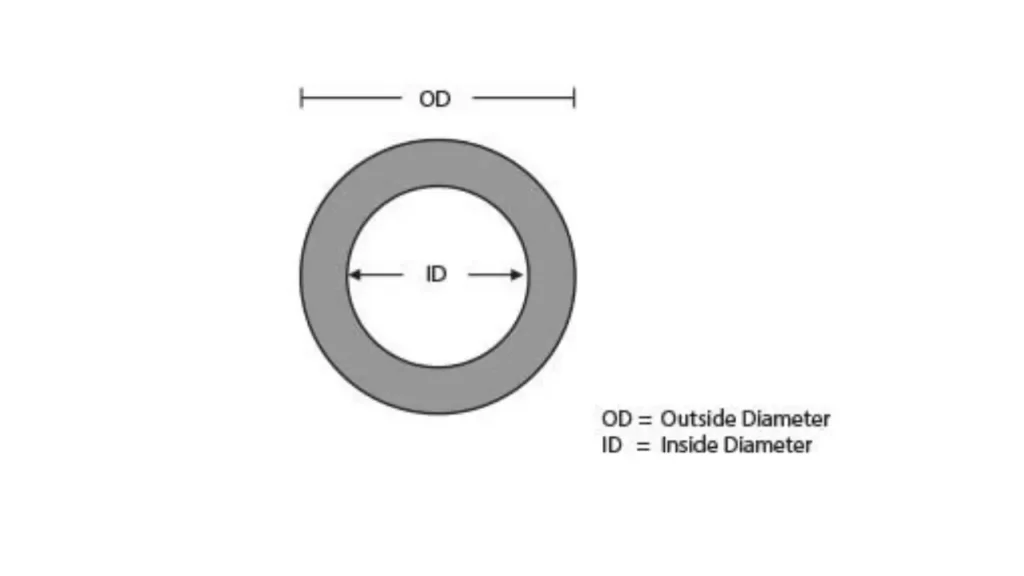
Reinforcement: Evaluate the type and number of reinforcement layers (e.g., single wire braid, double wire braid, spiral wire).
Higher levels of reinforcement generally provide greater strength and durability.
Cover Material:
Select a hose with a durable and abrasion-resistant cover material that can withstand the rigors of the application environment.
Couplings:
Choose appropriate couplings that are compatible with the hose and the system’s components. Ensure that the couplings are properly sized and installed to prevent leaks.
3. Consult with Our Hydraulic Hose Experts:
- Hydraulic Specialists: Consult with our experienced hydraulic engineers or technicians and we can provide guidance based on your specific application requirements.
- Hydraulic Hose Manufacturers: Contact reputable hose manufacturers for expert advice and product recommendations.
- Industry Standards: Refer to relevant industry standards and guidelines, such as those published by organizations like SAE and ISO.
4. Obtain Manufacturer’s Specifications:
- Carefully review the manufacturer‘s specifications for the selected hose, including pressure ratings, temperature limits, fluid compatibility, and other relevant information.
5. Regular Inspection and Maintenance:
- Regularly inspect the hose for signs of wear and tear, such as cuts, abrasions, kinks, or bulges.
- Replace any damaged hoses promptly to prevent failures and ensure the safety and reliability of the hydraulic system.
By carefully considering these factors and following these tips, you can select the most appropriate hydraulic hose for your specific application, ensuring optimal performance, safety, and longevity within your hydraulic system.
Hydraulic Hose Types
Here are some types of hydraulic hoses you need to know more categories by the hydraulic hose reinforcement layers.
1SN Hydraulic Hose
Construction & Design:
- Single-wire braid reinforcement: This is the defining characteristic. A single layer of steel wire braid is embedded within the hose’s structure for reinforcement.
- Inner Tube: Typically made from synthetic rubber compounds designed to be compatible with hydraulic fluids.
- Outer Cover: Manufactured from durable rubber or synthetic materials to protect the inner components from abrasion, cuts, and environmental factors.
Specifications:
- Pressure Rating: Generally designed for medium-pressure applications, typically up to around 3000 psi.
- Temperature Range: Typically operates within a range of -40°C to +100°C (-40°F to +212°F).
- Flexibility: Offers good flexibility and a relatively small bend radius, making it suitable for applications with limited space.
Applications:
Commonly used in agricultural machinery, construction equipment, and general industrial machinery where medium pressure and good flexibility are required.
Advantages:
- Cost-effective due to its simpler construction.
- Offers good flexibility for ease of installation.
- Suitable for a wide range of medium-pressure applications.
1SC Hydraulic Hose
Construction & Design:
- Very similar to the 1SN hose, with a single-wire braid reinforcement.
- May have slight variations in construction or material composition compared to the 1SN.
Specifications:
- Pressure rating and temperature range are generally comparable to the 1SN hose.
- Flexibility and bend radius are also similar to the 1SN hose.
Applications:
Used in similar applications as the 1SN hose, primarily in hydraulic systems operating under medium pressure.
Advantages & Limitations:
Offers similar advantages and limitations to the 1SN hose, providing a cost-effective solution for medium-pressure applications.
2SN Hydraulic Hose
Construction & Design:
- Double-wire braid reinforcement: This is the key distinguishing feature. It incorporates two layers of steel wire braid, significantly enhancing strength and durability.1
- Inner Tube and Outer Cover: Similar materials to those used in 1SN/1SC hoses, but designed to withstand higher pressures.
Specifications:
- Pressure Rating: Significantly higher than 1SN/1SC hoses, typically up to 5000 psi or more depending on the specific hose design.
- Temperature Range: Generally operates within a similar temperature range as 1SN/1SC hoses, though some specialized versions may have extended temperature ranges.
- Flexibility: Slightly less flexible than single-braid hoses due to the additional layer of reinforcement. Minimum bend radius is typically larger (e.g., 5-8 times the hose diameter).
Applications:
Ideal for demanding applications requiring high pressure and durability, such as heavy-duty construction equipment, mining machinery, and high-pressure industrial processes.
Advantages:
Superior pressure resistance and durability compared to single-braid hoses. Well-suited for harsh operating environments and high-stress applications.
2SC Hydraulic Hose
Construction & Design:
- Similar to 2SN hose with double-wire braid reinforcement.
- May have slight variations in construction or material specifications compared to the 2SN hose.
Specifications:
- Pressure rating is generally comparable to the 2SN hose, offering high-pressure capabilities.
- Temperature range is typically similar to the 2SN hose.
- Flexibility and bend radius are similar to the 2SN hose, with some potential limitations due to the double-braid construction.
Applications:
Used in high-pressure hydraulic systems where durability and strength are critical, such as in heavy machinery and demanding industrial applications.
Advantages & Limitations:
Offers enhanced pressure capacity and durability, suitable for high-stress environments. May have slightly less flexibility than single-braid hoses and may have a higher cost.
Conclusion
Understanding the key differences between R1 and R2 hydraulic hoses is crucial for selecting the right hose for your specific application.
By carefully considering the operating pressures, temperature ranges, and other factors specific to your application, you can select the appropriate hose type to ensure optimal performance, reliability, and safety within your hydraulic system.
Ready to find the perfect hydraulic hose for your needs? Request a Quote Today!

